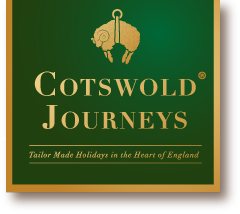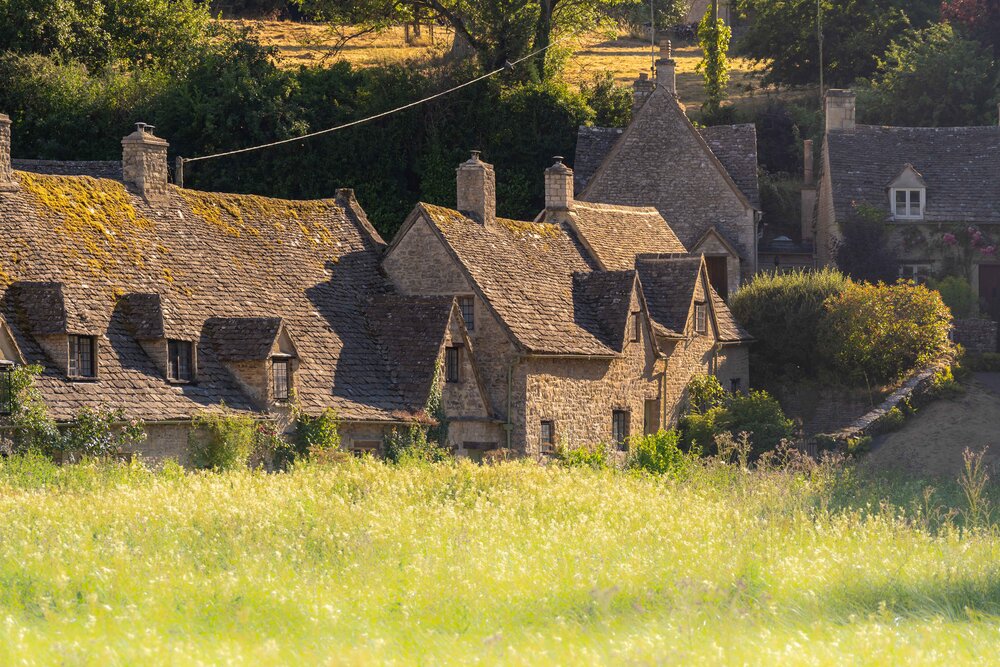Ablington, Arlington and Bibury
Ablington, which is a near neighbour of Bibury, is mentioned here only in passing, partly because it is another pretty village (albeit one with a fine, ancient double barn) but also because it is associated with a minor classic work of Cotswold literature. J. Arthur Gibbs, who wrote the 1898 book “A Cotswold Village”, a description of country life in the late Victorian age, lived at Ablington Manor, which was built for a Cirencester wool merchant, John Coxwell, in 1590.
History of Bibury Bibury is actually two small villages separated by the river Coln which flows alongside the main street. To the east is Bibury, to the west Arlington. How or why it is that one name predominated is unknown.
The village may have connections with the Dobunni, the most important in the region of the pre-Roman British tribes. Early occupation is evidenced by Rawbarrow Camp, an Iron Age settlement which looks down upon the village from the valley top. It was the Romans who first settled the site where the existing village stands – a Roman villa was discovered to the east of Bibury Mill. It may be that the large estate that Bibury eventually became succeeded the Roman villa, which explains the exceptional size of the Saxon church.
The Saxons gave us the names of ‘Bibury’ and ‘Arlington’. In the early 8th Century the settlement was held by Earl Leppa, who ceded it to his daughter Beage, after which the village became known as Beage’s Bigbury (a ‘bury’ being a fortified place) which eventually became ‘Bibury’; whilst. Arlington means the ‘farmstead belonging to Aelfred’. Judging by the Saxon elements in the church, Bibury must have been a place of some importance to the Saxons.
Although the village prospered on account of the medieval wool trade. it is thought that up to seventy per cent of its population was lost to the Black Death of 1348.
Most of the stone buildings you see now were built in the seventeenth and eighteenth centuries, when agriculture was the source of its prosperity, with the mills in both Bibury and Arlington built in about 1790. The nineteenth century, however, saw a general decline in agriculture and Bibury, along with the rest of the Cotswold villages, fell upon hard times, until the Arts and Crafts Movement and the availability of mass transport revived it in the early 20th century.
There is no doubt that Bibury has a lot of charm. Arlington Row, for example, a line of ancient cottages at the foot of Awkward Hill, is an image of ridiculously picturesque charm. The row was built in about 1380 as a woollen store by monks. In front of it, on the large marshy area known as Rack Isle, wool was dried on wooden racks after the fulling process. In Cotswold Country published in 1937 HJ Massingham states ‘Bibury really deserves what has been written about it……its architectural graces, epitomizing all that we mean by cottage England, deserve the extraordinary felicity of their site under the woody ridge…..One of the delights of Bibury is the gradations of contrast between the utra-solid, buttressed mill house by the bridge, the long front of Arlington Row facing it and the vagrom cottage groups between them, lying back from the river with their gables little and great jutting out at all angles.’ The problem with Bibury is that its reputation as the quintessential Cotswold village has turned it into a sedate inland resort, which means that to take a solitary walk alongside the stream or linger on the bridge and stare unhurried into its trout-filled waters, is not easy. Nonetheless, like a lot of honey-pots, people linger at the centre – walk a little way off-centre and there is much to admire.
Arlington is known as the ancestral home of John Custis II, who emigrated to the Colony of Virginia and named his palatial four-story brick mansion (built in 1675) in Northumberland County, Virginia after the village. Arlington was abandoned after fifty years, but the name was revived by his great-great-grandson, George Washington Parke Custis for his large estate on the south shore of the Potomac River near Washington, D.C. Arlington Estate was later owned by American Civil War General Robert E. Lee and today has become the Arlington National Cemetery.
The Church
The Saxon church is mid to late 11th century, enlarged in the late 12th and early 13th centuries, clear from the exterior of the south nave wall. A section of wall immediately to the left of the aisle is 11th century, with an original surviving circular clerestory window, whilst a part of a Saxon cross is embedded in the exterior of the chancel north wall. Many of the tombs in the churchyard belonged to wealthy clothiers and merchants. The north doorway, with its zig-zag mouldings, is Norman. Within, Saxon nave pilasters survive in the north aisle above the arcade, along with the tall Saxon chancel arch. Elsewhere, worth noting is the extensive and elaborate Norman carvings of scallops and other designs. The roof is a spectacular ten-bay Perpendicular tie-beam system. The extent of Saxon remains allows a reasonable reconstruction of the immediate pre-conquest church. Of great interest also are the Transitional features, especially the carved capitals to the north arcade, part of a series of alterations by the monks of Oseney after their appropriation of the church in 1151.
Elsewhere in Bibury
You might consider taking tea at the Bibury Court Hotel, a Jacobean mansion, built on the site of a former Benedictine monastery. It dates from the late 16th Century, and was then extended in 1633 by Sir Thomas Sackville, the illegitimate son of the 1st Earl of Dorset who was ‘Knight and gentleman-usher in dailie waiting on the King’ (James I). Charles II is reputed to have visited the Court when he attended Bibury Races (run on the downs between the nearby village of Aldsworth, and Burford), as did the Prince Regent during the reign of George III.
The house remained in the Sackville family for several generations and through the female line passed to the Cresswells, who, owing to a disputed will and years of litigation, sold the house in the last century to Lord Sherbourne. Charles Dickens is said to have written ‘Bleak House’ with this court case in mind. The interior was remodeled for Estcourt Cresswell in 1759. It fell into disrepair in the 1920s before being refurbished for the Clark family in 1922 in whose ownership it remained until 1968 when after the death of Lady Clark it was sold and turned into a hotel.
And then there is the Catherine Wheel pub, dating back to the 15th century, a beautiful Cotswold stone building with a stable courtyard and orchard. In 1803 the family of William Taylor lived and worked as blacksmiths in the building, shoeing horses and making cart wheels. In 1856 The Catherine Wheel was born: the building was bought by J. Hathaway, a cooper (barrel-maker) and beer retailer. With its low beams, stone walls, and large log fires, the inn became a success. Mr. Hathaway died leaving the inn to his wife, who sold it to the Nailsworth Brewery Company Ltd in 1899.
Finally, there is the Bibury Trout Farm, a working trout farm in the village center founded in 1902. Visitors can buy fresh or smoked trout from the farm shop or catch their own at the beginner’s fishery.


0 Comments